Self-propelled artillery installation Sd.Kfz.251 / 22 (Germany)
At the end of 1944, another attempt was made to create the required equipment for self-propelled artillery units based on the available machines and armaments. A similar approach to the development of armored vehicles, which has already been tested many times in previous projects, made it possible to minimize the time it took to create new models, as well as to simplify their production. In the face of acute problems in all directions, the use of other approaches would be unwise. A new project of self-propelled artillery projectiles should be based on ready-made developments.
Once again, the basis for the specialized armored vehicle was to be the middle semi-tracked armored personnel carrier Sonderkraftfahrzeug 251. This combat vehicle was produced serially from the late thirties and was well mastered by the troops. At its base, a significant number of various-purpose vehicles, including self-propelled guns of various types, have been already produced. Now the Bd Sd.Kfz.251 was to become the carrier of the 7,5 anti-tank gun cm PaK 40. Such a weapon still had high enough performance and could hit the enemy’s armored vehicles.
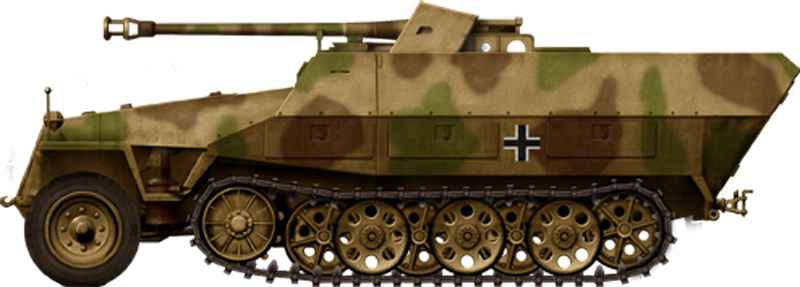
Reconstruction of the appearance of ACS Sd.Kfz.251 / 22. Figure Tanks-encyclopedia.com/
In accordance with the German designation system, the new project was called mittlerer Schützenpanzerwagen mit 7,5 cm PaK 40 - “Medium armored vehicle with 75-mm PaK 40 cannon”. Being a modification of an existing armored personnel carrier, the self-propelled gun was designated Sd.Kfz.251 / 22. Also used is the factory designation Gerät 922.
Theoretically, Sd.Kfz.251 armored personnel carriers of any modifications could theoretically be used as a base for the new ACS. However, by the time the decision was made to release such a vehicle, the old versions of the BTR were discontinued, and the industry switched to the construction of Ausf.D. As a result, all serial self-propelled guns Sd.Kfz.251 / 22 were built on the basis of newer armored personnel carriers. There is no information about such an application of machines of earlier versions up to “C”.
The Sd.Kfz.251 Ausf.D armored personnel carrier was serially produced from the middle of the 1943 year. It differed from its predecessors by the simplified design of the case, consisting of fewer parts. However, some frontal parts slightly increased their thickness. Despite the processing of the case, the layout of the machine and the composition of the various units remained the same. In the front engine compartment of a small size fit the engine and transmission units. Behind the engine compartment was a large compartment to accommodate the crew and landing force.
From bullets and fragments, the frontal projection of the vehicle was protected by armor plates up to 15 mm thick. A hexagonal frontal sheet was used, behind which was a sloping roof with side parts located at an angle to the vertical. The habitable compartment had a sloping frontal sheet of small height with inspection hatches. Boards consisted of several parts and received an inclined top sheet. The thickness of the sides and the stern was 8 mm. A distinctive feature of the project Sd.Kfz.251 Ausf.D was the stern, made of one inclined sheet.
To install the new weapons, implied by the mittlerer Schützenpanzerwagen mit 7,5 cm PaK 40 project, it was necessary to provide for some modifications of the armored corps. So, on the site of the troop compartment, which was being converted into a combat one, it was proposed to mount systems for the installation of the gun. In addition, I had to make a large cut in the front narrow roof of the hull. This cutout was necessary in connection with the dimensions of the gun and was designed to accommodate the recoil devices.
Under the hood of a half-track self-propelled gun, the Maybach HL 42TUKRM hp 99 hp carburetor engine had to remain. The engine was connected to a mechanical transmission based on a gearbox with four forward speeds and two reverse gears. For driving on the highway and rough terrain, the box had two different modes with different gear ratios. Using the transmission, the engine was connected to the front drive wheels of the tracks.
A semi-tracked undercarriage consisting of a single wheel axle and a tracked propulsor was used. Steering wheels were installed using spring suspension. The tracked undercarriage had six support rollers of chess arrangement with an individual torsion bar suspension on each side. The drive wheels were placed in the front of the track, the guides in the rear. The semi-tracked armored personnel carrier had an original steering system. The machine had to turn at small angles with the help of steered wheels, and at large angles - with the help of wheels and power redistribution on the tracks.
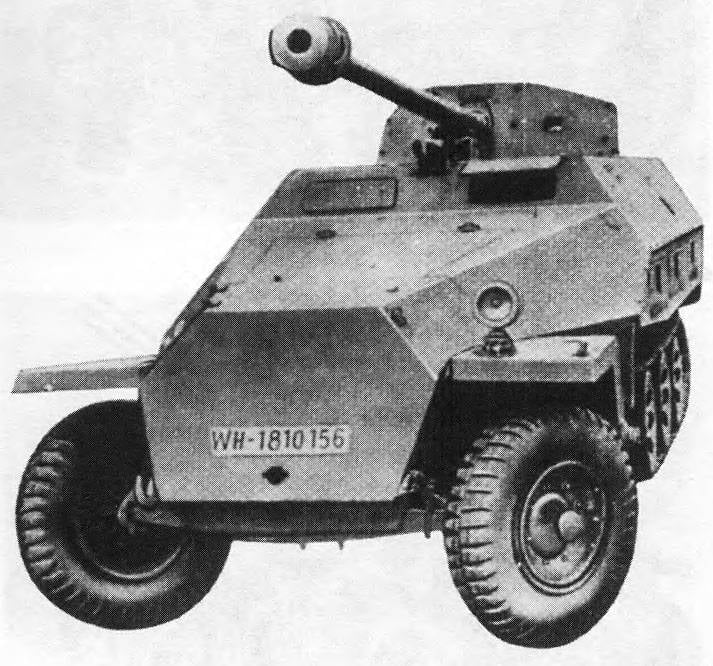
General view of self-propelled guns. Photo by Chamberlain P., Doyle H. "Complete German Reference tanks and self-propelled guns of World War II "
In the central part of the fighting compartment of the corps, a new project proposed to install a cabinet for mounting the required gun. It provided for the installation of the carriage of the existing design, as well as elements of the drive guidance. To simplify production, it was decided to use, together with the gun, a number of units of its basic towed carriage. In this way it was planned not only to simplify production, but also to solve some other design tasks related to the layout of the crew compartment and the additional protection of the crew.
Initially, the anti-tank gun 7,5 cm PaK 40 was produced in towed version on a carriage with a wheel course. The gun with recoil devices and double armor shield mounted on a platform with a wheel course, equipped with beds and an additional shield. For installation on a self-propelled chassis, it was proposed to remove the wheeled carriage with the beds, and the rest of the parts had to be mounted on a pedestal inside the case. In this case, the gun barrel was above the frontal hull sheet, and the armor shield protruded above the machine, providing additional protection for the calculation.
Interestingly, the tool assembly system used in the project was not developed from scratch. A bit earlier, a similar cannon mount was used in the Sd.Kfz.234 / 4 wheeled armored vehicle design. On the existing chassis was mounted a new armored cabin with a serial weapon PaK 40, for the installation of which some new units were offered. After some refinement, such units could also be used on a semi-tracked chassis.
The 75-mm PaK 40 anti-tank gun had a barrel-length 46 caliber and could use unitary shots with projectiles of various types. Depending on the type of ammunition used, the gun accelerated the projectile to the speed of 930 m / s and could penetrate up to 150 mm of homogeneous armor from a distance of 500 m. At a distance of 1 km, armor with a thickness of 97 mm was struck. A trained crew could fire at a rate of up to 14 shots per minute.
The installation of the gun on the new installation of the self-propelled chassis led to a change in some characteristics. First of all, the angles of guidance have changed. Due to the limitations imposed by the interaction of parts of the gun and the body, there was the possibility of horizontal guidance on 20 ° to the left of the neutral position and on 18 ° to the right. Vertical guidance was carried out in the range from -3 ° to + 22 °. Other parameters of the gun remained at the same level, since it was decided to abandon changes to any parts not related to mounting the system on the chassis.
In the stern of the fighting compartment placed piling for ammunition. At the disposal of the artillery calculation there was a 22 unitary projectile. For a longer shooting self-propelled gun needed the help of ammunition carriers.
The Sd.Kfz.251 / 22 project provided for the use of additional armament for self-defense in the form of a single MG 34 or MG 42 machine gun. Depending on the situation, the crew could use a machine gun together with a standard aft installation or as a manual one.
The self-propelled crew consisted of only four people. In his regular place in front of the habitable compartment had to be a driver. Three other crew members housed in the fighting compartment. The commander, gunner and loader had to monitor the situation, find targets and fire. The composition of the observation equipment available to the crew corresponded to the design of the base armored personnel carrier: the driver’s and commander’s seats in front of the vehicle were equipped with inspection hatches. Other jobs did not have such equipment, since the crew was asked to observe the situation “over the side”. For landing in the car it was proposed to use a standard hull door.
The dimensions of the perspective ACS, with the exception of height, corresponded to the parameters of the base BTR of a late modification. At the same time, the overall height of the vehicle increased to approximately 2,2 m, and the combat weight also increased significantly. The mobility of self-propelled guns should have deteriorated in comparison with the base armored personnel carrier. The speed on the highway could not exceed 50 km / h, power reserve - 290-300 km.
The development of the mittlerer Schützenpanzerwagen mit 7,5 cm PaK 40 or Sd.Kfz.251 / 22 project was completed in the late autumn of the 1944 year, after which the construction of the prototype began. The first prototype of the semi-tracked ACS was presented at the very beginning of December. Soon the car was tested, after which it was decided to deploy mass production. According to the available data, already at the testing stage, some design problems were identified, however, despite them, the command ordered to launch the series.
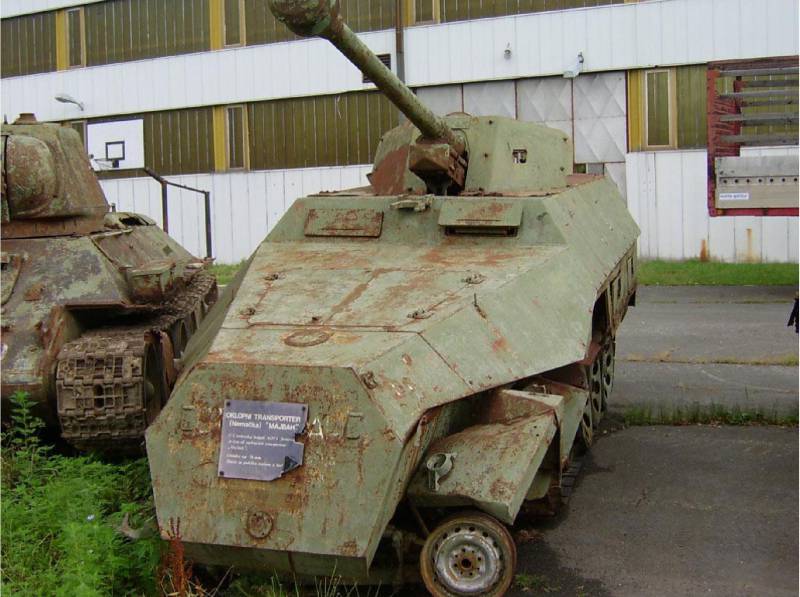
The surviving Sd.Kfz.251 / 22 in one of the museums of Bosnia and Herzegovina. Photo The.shadock.free.fr
According to the plans of the end of 1944, the new self-propelled artillery mounts were to be supplied to tank divisions arr. 1945 g. It was assumed that each such compound will receive several dozen new-type machines. Nine self-propelled guns were intended for the anti-tank division, three more should be transferred to the reconnaissance division. Each tank division of the division should have six Sd.Kfz.251 / 22 for fire support.
Production of new self-propelled guns with 75-mm guns was carried out using ready-made equipment. The basis for most of these vehicles were Sd.Kfz.251 Ausf.D armored personnel carriers, returned to the rear for repairs. With this technology removed more unnecessary units, instead of which were placed inside the body of new weapons. After the repair and modernization of armored vehicles, armies were returned and distributed among various units in accordance with the existing plan. Production of machinery continued for several months, after which the deterioration of the situation on the fronts forced the industry to refuse to release such semi-tracked self-propelled guns. For all the time it was built no more than a hundred cars. According to others, the number of serial equipment has reached 250 units.
Experiencing an acute shortage of necessary equipment, the German troops were forced to actively use new self-propelled guns. In the course of their operation, problems identified at the testing stage were confirmed. With an acceptable firepower that allowed them to fight some of the Allied armored vehicles, the Sd.Kfz.251 / 22 did not have good reservations. In addition, the 7,5 cm PaK 40 gun was too heavy for the half-a-crawler chassis, and its recoil was unacceptably powerful. As a result, cross-country maneuverability deteriorated in comparison with the base armored personnel carrier, and in addition, the wear and tear of equipment increased. All this made it difficult to transfer cars on the road, and sometimes led to breakdowns of the chassis.
Such an ambiguous combination of technical and operational characteristics led to the fact that part of the armored vehicles failed due to the enemy fire, and other self-propelled guns broke themselves. Unable to carry out repairs, the crew was forced to abandon their equipment and leave. A certain number of SPGs became enemy trophies. For example, it is known that several of these machines, used on the territory of Yugoslavia, changed owners and after that were already used against the German troops.
Despite the losses observed until the very end of the war, by the summer of 1945, a number of ACS mittlerer Schützenpanzerwagen mit 7,5 cm PaK 40 could still be used by the troops. Most of the serviceable armored vehicles belonged to the Yugoslav army. Experiencing certain difficulties, she continued to exploit trophies for a long time. The last Sd.Kfz.251 / 22 of the armed forces of Yugoslavia were written off only by the mid-fifties. A few cars that were used even after World War II have survived to the present day. There are also replicas of similar equipment based on later-release armored personnel carriers, based on the Sd.Kfz.251 design.
Initially, the mittlerer Schützenpanzerwagen mit 7,5 cm PaK 40 or Sd.kfz.251 / 22 semi-tracked self-propelled artillery mounts project looked promising. The mastered mass chassis could give the car high mobility characteristics and ease of operation, while the 75-mm gun still allowed to deal with the enemy's equipment with a sufficiently high efficiency. However, in practice, it turned out to be too heavy a machine with insufficient protection, which led to sad consequences for the German army. Attempting to build a new armored vehicles with the required weapons at the final stage of the war did not end in success and did not yield the expected results.
Based on:
http://tanks-encyclopedia.com/
http://achtungpanzer.com/
http://pro-tank.ru/
http://armor.kiev.ua/
http://forum.axishistory.com/
Chamberlain P., Doyle H. Complete reference book of German tanks and self-propelled guns of the Second World War. - M .: AST: Astrel, 2008.
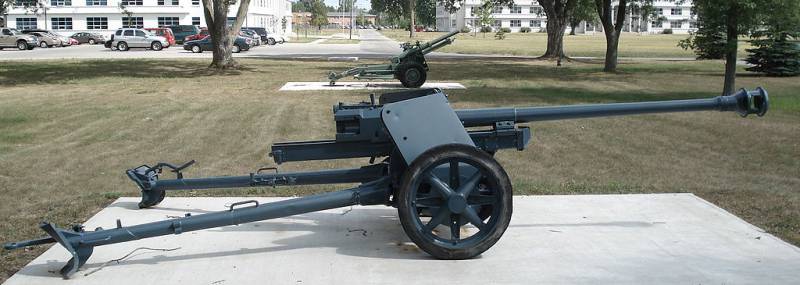
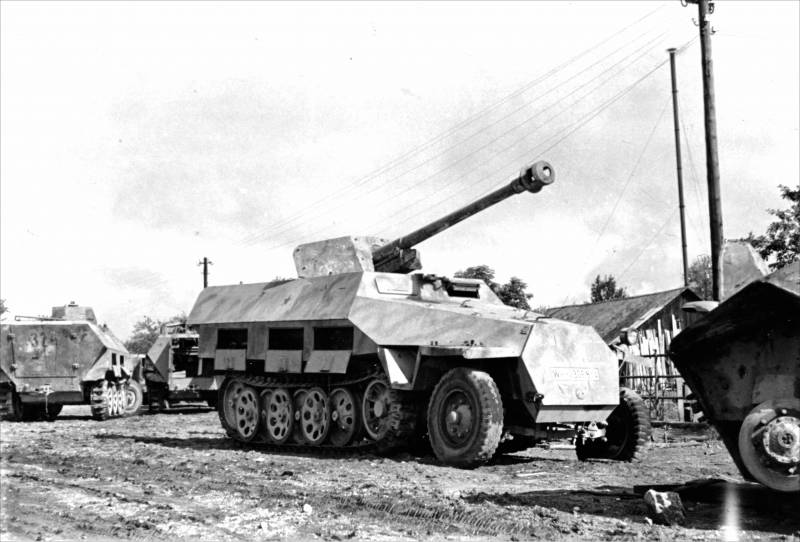
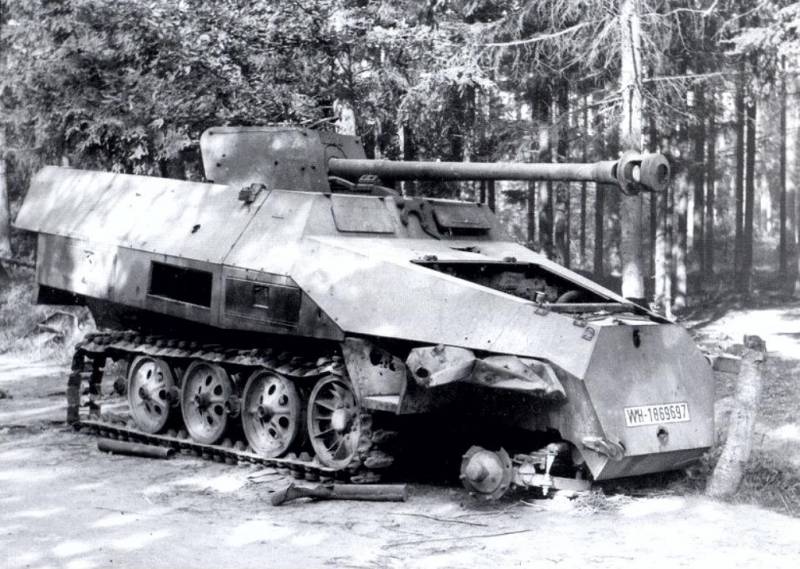
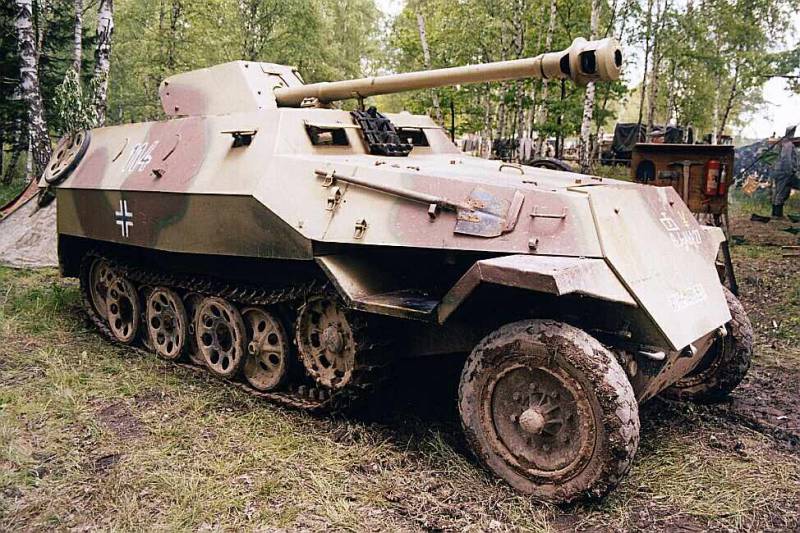
Information